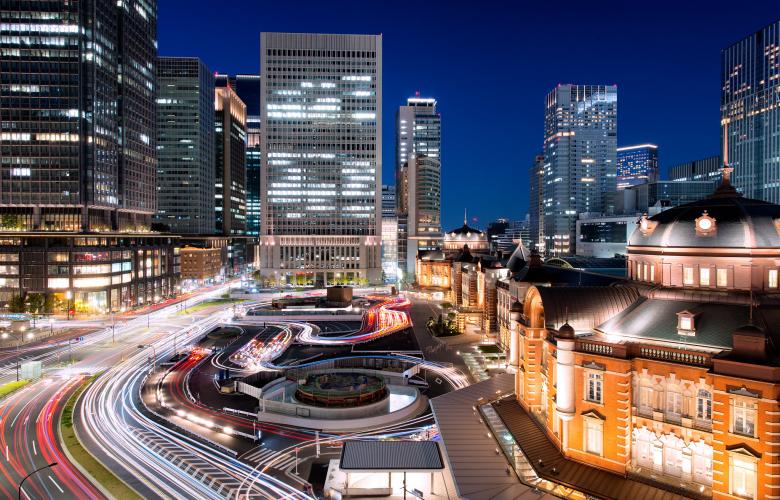Once a marshland, Marunouchi had an image problem
Marunouchi — meaning ‘within (the castle walls)’ in Japanese — is the compact area sandwiched between the eastern border of the Imperial Palace and Tokyo Station. While centrally located today, it used to be on the periphery of the Japanese capital a little more than a hundred years ago. In 1592, when Tokugawa Ieyasu — who would later become the shogun of Japan and ring in the Edo era — moved into Edo Castle, the area was flooded to create an inner moat.
Soon after, the second homes of daimyo (warlords associated with the shogun) were erected around the moat. The shogun demanded the daimyo to spend every other year in these homes, away from their own lands where they ruled, to prove their solidarity to the shogun. However, once the shogunate ended in 1867, so did that use of the area, and its control fell to the Meiji government that abolished the samurai class. The government transformed it into a military exercise ground, erected barracks and used part of the land for drills and parades.
Mitsubishi bought the Marunouchi area for a mere JPY 1.5 million
It seems that no one saw potential in the area, despite its close proximity to the Imperial Palace that forms the geographic heart of Tokyo today. A quote by the famous writer Tayama Katai sums up its appearance around the end of the 19th century: ‘Marunouchi was a terribly dismal place, with a lonely, bleak, desolate air to it, and the Imperial Palace seemed shut away in the clouds.’ In addition, as it was once used as a moat and low-lying plain, the area was more prone to flooding, liquefaction and other damages associated with water; hence the lack of interest from real estate investors in Japan. However, Mitsubishi Corporation, originally founded as a shipping company, was trying to expand from the unstable and risky sea trade it had solely relied on and contemplated the jump from sea to land.
So Shoda Heigoro and Suenobu Michinari, two of Mitsubishi’s top managers at the time, urged Yanosuke Iwasaki, banker and the brother of Mitsubishi Corporation's founder, to invest in the land for Mitsubishi. Iwasaki proceeded to buy it from the Meiji government for JPY 1.5 million — the biggest expense for the corporation in the year 1890.
125 years of constant development
The risk they took paid off after only a few decades. While the Mitsubishi Group had a vision of Marunouchi becoming a sparkling business district that rivals the ones they visited on trips to Europe and North America, it took years for Tokyoites to buy into their idea. The first development of the area in 1894, called Londontown, imitated the red brick and white quoin buildings that Shoda and Suenobu saw on a trip to the British capital. The area had great charm – picturesque streets lined with buildings in the style of today’s Tokyo Station — but no convenient railway access yet, so most corporations stayed put in Nihonbashi to the east.
It was only when Tokyo Station was opened in 1914 that the area fully came to life. By 1922, one-third of Japan’s largest corporations had relocated their headquarters to the Marunouchi area.
The Marunouchi area today
Today, the Marunouchi district is still considered the prime location for any corporate office in Tokyo and much of the area remains under the control of the Mitsubishi conglomerate. The 1.2 km2 area between the Imperial Palace and Tokyo Station accommodates more than 4,000 domestic and international blue chip corporations. Around 230,000 office workers commute to the area daily. According to the Mitsubishi Corporation, 18 of those companies are listed in the Fortune 500, putting Marunouchi ahead of both New York Midtown and London City. There are 4,300 foreign financial institutions based here as well, making it the most important financial centre in Japan.
Notable corporations in the area — besides the obvious Bank of Tokyo-Mitsubishi UFJ, Mitsubishi Corporation, and Mitsubishi Electric —include Hitachi, Citigroup, JPMorgan Chase, Bloomberg, KPMG, PricewaterhouseCoopers, Standard Chartered Bank, and Deloitte Touche Tohmatsu, to name a few.
Ongoing, large-scale redevelopment
A large-scale redevelopment project that started in the early 2000s has shaped Marunouchi into what it is today. Latest additions include the glass-and-steel high-rise Marunouchi Park Building completed in 2009, the Shin-Marunouchi Building (2007), the Tokyo Building (2006), the Marunouchi Building (2002), and the Mitsubishi Trust & Banking Head Office (2003). The ongoing redevelopment project has added commercial facilities (like shopping malls and restaurants), art museums and urban green spaces to turn the area's image from that of a CBD dominated by cold steel into that of an area of work and play. Mitsubishi’s plan is working out very well — Tokyoites now flock to the area on evenings and weekends to enjoy the vast shopping and dining options.
By Mareike Dornhege
Similar to this:
Chiyoda area guide: Japan’s centre of political power
Chuo area guide: Ginza, Tsukiji and reclaimed land
Six of Tokyo's best foodie neighbourhood





